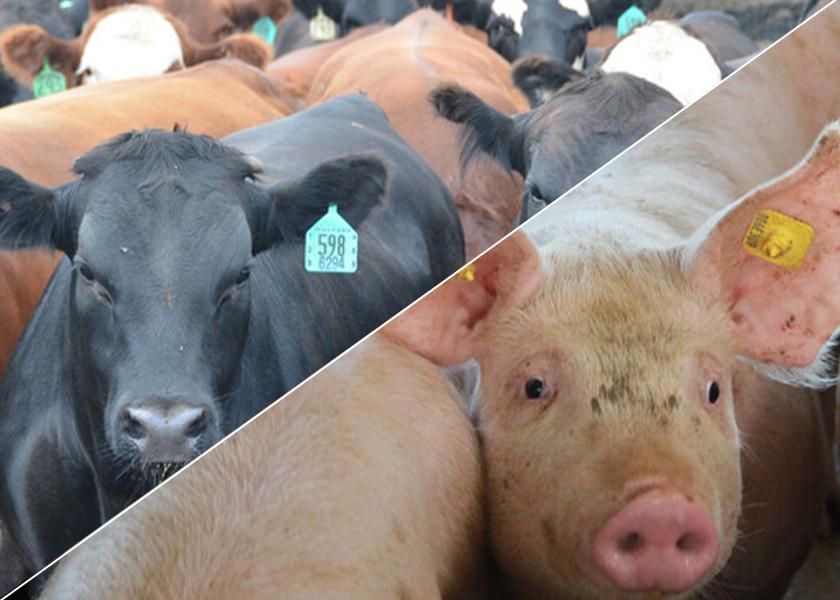Livestock Analysis | May 12, 2022

Price action: June lean hogs fell $3.375 at $97.475, the contract’s lowest closing price since Jan. 11.
Fundamental analysis: Hog futures extended a sharp slump on bearish cash market fundamentals, demand concern and weak technicals. Losses in cattle futures markets and a surge in the U.S. dollar index to a fresh 20-year high also weighed on hogs. USDA reported a slight improvement in weekly U.S. pork export sales at 26,300 MT for 2022, up 10% from the previous week and up 14% from the prior four-week average.
The CME lean hog index rose 17 cents to $101.26 today, the highest since April 29. The projected quote for Friday (as of Wednesday) is $101.04, down 22 cents from Tuesday’s official figure. June futures are trading at a discount to the cash index, which is rare for this time of year and illustrative of heavy bearish sentiment. The national direct five-day rolling average cash hog price was quoted at $104.54 today. Pork cutout values early today rose $1.23 to $100.72. Loins and hams led the gains. Movement was 152 loads.
Technical analysis: Bears have a solid overall near-term technical advantage. Prices are in a six-week-old downtrend on the daily bar chart. The next upside price objective for the hog bulls is to close June prices above solid chart resistance at $105.00. The next downside price objective for the bears is closing prices below solid technical support at $95.00. First resistance is seen at $100.00 and then at $101.00 First support is seen at today’s low of $97.70 and then at $97.00.
What to do: Cover all soybean meal needs in the cash market through May. Be prepared to extend coverage on further price weakness. You are hand-to-mouth on corn-for-feed needs.
Hedgers: Carry all risk in the cash market for now.
Feed needs: You have all soybean meal needs covered in the cash market through May. Be prepared to extend coverage on price weakness. You are hand-to-mouth on corn-for-feed needs.
Price action: June live cattle fell $1.925 to $131.65, the lowest closing price since early October. August feeder futures fell $3.475 to $166.525.
Fundamental analysis: Cattle futures sank to seven-month lows on weaker cash prices and concern costly beef is hurting demand. Live steers so far this week have averaged about $142.17, down from last week’s average of $143.63. Weakness in Choice beef cutouts values his week, a time of year usually marked by strength as retailers stock up for summer grilling, bodes bearishly for futures. Choice cutouts rebounded $1.14 early today to $256.22, still well below last week’s average at $258.29.
The USDA Supply and Demand report didn’t help the short-term bullish cause either. For example, USDA boosted its estimate of 2022 U.S. beef production 130 million pounds to 27.910 billion and raised its domestic import forecast 105 million to 3.545 billion while raising its export forecast by just 56 million (to 3.356 billion pounds). In contrast, USDA analysts put their initial 2023 U.S. production forecast at just 26.018 billion pounds; they slashed their 2023 U.S. beef export forecast by 426 million while trimming next year’s import projection by just 345 million. Still, they’re quite optimistic about the price outlook, projecting a fourth-quarter cash average for steers at $145 and predicting the 2023 average at $153.00. We tend to view these price forecasts as overly optimistic.
Technical analysis: Bears hold a short-term technical advantage in June cattle futures. Bulls couldn’t force a move above initial resistance at the contract’s 10-day moving average near $133.57 or pierce stronger resistance at the 40-day moving average near $135.55. Today’s low at $131.525 looks like initial support, with stronger support persisting at the March 4 low of $130.975. A drop below that level would have bears targeting the important $130.00 level, then $127.50. This week’s losses have also carried the nearby June price below the 40-week moving average and upward trendline in place since the spring of 2020 on the weekly continuation chart, implying a longer-term bearish advantage as well.
Bears hold the strong technical advantage in August feeder futures, with the close at $166.525 being exceeded on the downside by only the contract low of $166.075 posted September 13, 2021. Look for initial resistance around the April 27 low at $168.525, then at the 10- and 40-day moving averages near $172.65 and $174.85, respectively. The continuation chart indicates additional support around $162.85, then the $160.00 level.
What to do: Cover all soybean meal needs in the cash market through May. Be prepared to extend coverage on further price weakness. You are hand-to-mouth on corn-for-feed needs.
Hedgers: Carry all risk in the cash market for now.
Feed needs: You have all soybean meal needs covered in the cash market through May. Be prepared to extend coverage on price weakness. You are hand-to-mouth on corn-for-feed needs.






